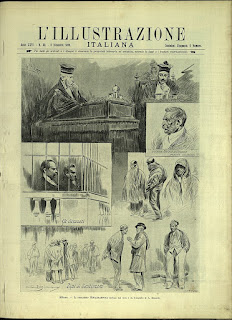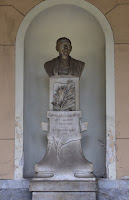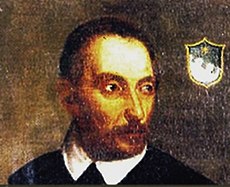First major figure to be assassinated by Mafia
 |
| Emanuele Notarbartolo spent 14 years in charge of the Banco di Sicilia |
Notarbartolo served as a conservative Mayor of Palermo from 1873 to 1876 and director of the Banco di Sicilia from 1876 to 1890.
He saved the bank from going bust by stamping down on the practice of doling out large and effectively unsecured loans to favoured individuals but in doing so made many enemies.
Having survived being kidnapped in 1882, Notarbartolo was stabbed to death in his first-class compartment on a train just outside Palermo, his body thrown out of the carriage on to the track side.
Although ultimately they were set free as the legal process broke down, Raffaele Palizzolo, a rival politician with Mafia connections as well as a fellow member of the Banco di Sicilia board, and a boss of the Villabate mafia clan, Giuseppe Fontana, were identified as being responsible for his death. Each was sentenced to 30 years in prison.
Murders involving members of the Cosa Nostra were commonplace but the victims were generally other mafiosi or associates. Notarbartolo’s death is thought to have been the first instance of a politician or other prominent public figure being killed on Mafia orders.
Notarbartolo was born into one of Palermo’s most important aristocratic families and was given the title Marquis of San Giovanni. Orphaned as a child, he moved to Paris in his early 20s and then to London, where he developed a passion for economics and politics, becoming a supporter of liberal conservatism which on his return to Italy placed him on the Historical Right.
 |
| Newspapers in Italy covered the trial of Notarbartolo's alleged killers extensively |
Notarbartolo’s participation was rewarded with public office in Palermo, where he was for a while assessor of the city’s police force before being appointed president of the civic hospital. In his capacity as Mayor, to which office he was elected in September 1873, he promoted the construction of Palermo’s enormous opera house, the Teatro Massimo.
He developed a reputation for moral integrity, thanks to which he was appointed General Manager of the Banco di Sicilia in February 1876 at the behest of the Rome government led by Marco Minghetti.
His brief was to reorganise the banking system on the island, which had fallen into such chaos that the Banco di Sicilia was at the brink of bankruptcy, threatening dire consequences for the entire Sicilian economy.
Notarbartolo soon discovered that incompetent bank managers were granting substantial loans to so-called entrepreneurs and builders purely on the basis of patronage, without asking for guarantees and allowing generous repayment terms.This impacted on a considerable number of powerful people in Palermo, politicians and criminals alike, who had become used to easy finance with no questions asked. It was not long before there were plots to oust Notarbartolo.
 |
| Notarbartolo's rival Raffaele Palizzolo was one of the accused |
Yet he was not intimidated, even when he was kidnapped. After paying 50,000 lire as a ransom, he was released unharmed and vowed to redouble his efforts to rid the bank of corruption. By now he had several rows with Palizzolo and suspected that his rival was behind the kidnap, although it was never proved.
He wrote to the Minister of Agriculture and Commerce in Rome, outlining the lax and corrupt practices he had exposed, but the letter was somehow intercepted and fell into the hands of Palizzolo, who informed the other members of the bank’s board. In 1890, his opponents, with the backing of Francesco Crispi’s government, forced Notarbartolo to resign.
After his successor as director of the bank made a number of reckless and costly decisions, there was talk of Notarbartolo being reinstated. Days after this came to light, he was killed.
Soon after the train carrying Notarbartolo towards Palermo from his country estate near Sciara left the station at Trabia, some 33km (21 miles) southeast of the capital along the Tyrrhenian coast, it entered a tunnel, at which moment two men entered the banker’s compartment and attacked him, stabbing him 27 times. His body, thrown from the compartment, was found in undergrowth by the track.
Fontana and two supposedly complicit railway workers were arrested, but a court in Palermo quickly acquitted Fontana and convicted the railway workers. Despite testimony from a carabinieri officer pointing to him as a possible instigator of the murder, Palizzolo - by then a member of the Chamber of Deputies - was never called.
Further trials in Milan and Bologna eventually found Fontana and Palizzolo guilty, the former of killing Notarbartolo, the latter of commissioning the murder. Each was sentenced in 1902 to 30 years in prison, only for the Supreme Court of Cassation in Rome to overturn the verdicts a year later on the basis of procedural defects.
A new trial took place in Florence in 1904 at which a new witness was to be produced on behalf of the prosecutors after another mafioso, Matteo Filippello, had confessed to being the other man in the railway carriage attack. A few days before he was due in court, however, Filippello was found dead, police reporting that he had hanged himself.
Fontana and Palizzolo were both then acquitted on the grounds of lack of evidence, the latter apparently welcomed by a cheering crowd on his return to Palermo.
 |
| Notarbartolo's bust in Palazzo Pretorio |
Emanuele Notarbartolo is commemorated in Palermo in the Via Emanuele Notarbartolo, an important street in the city, part of a long, straight thoroughfare that stretches across the city from the harbour area in the direction of Monte Cuccio to the west. The street, which intersects with the Via della Libertà, has a modern feel with a mix of shops, offices and apartment buildings and a scattering of Liberty-style villas typical of the city. Palermo Notarbartolo station can be found halfway along. A bust of Notarbartolo, carved by Antonio Ugo, can be seen in Palermo’s Palazzo Pretorio, where the city’s municipal council meets.
Stay in Palermo with Booking.com
 |
| Sciara, which sits on a plain in the shadow of Monte San Calogero, was founded by Notarbartolo's ancestors |
Sciara, where Emanuele Notarbartolo lived when away from Palermo, is a village just over 40km (25 miles) southeast of the Sicilian capital within the Monte San Calogero Nature Reserve, with its characteristic lush vegetation. The municipality was founded in 1671 by one of Notarbartolo’s ancestors, Baron Filippo Notarbartolo, by royal decree of Charles II of Spain. It was one of more than 30 fiefdoms owned by the family. Filippo built Sciara’s elevated castle and a couple of churches, including the Chiesa di Sant’Anna. The area is quite poor and many houses were left empty after families emigrated to the north of Italy, to Germany and the United States in the 1970s and ‘80s. Those villages who remain are often involved in the production of tomatoes, olives and artichokes.
Accommodation in Sciara from Booking.com
More reading:
The Sicilian lawyer who made it his life's work to take on Mafia
The Palermo businessman who refused to pay
The president’s brother killed by the Mafia
Also on this day:
1507: The death of Renaissance painter Gentile Bellini
1806: The birth of military general Manfredo Fanti
1821: The death in Rome of English poet John Keats
1822: The birth of archaeologist Giovanni Battista de Rossi
1910: The birth of artist Corrado Cagli
(Picture credits: Notarbartolo bust by Sicilarch; Sciara panorama by Azotoliquido; via Wikimedia Commons)


.jpg)
.jpg)


.jpg)


.jpg)

.jpg)
.jpg)





.jpg)




.jpg)



